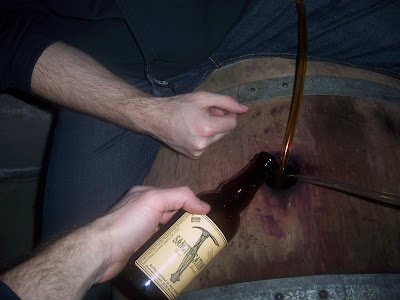 Here's a tasting of the "Golden Lager" I did brewed quite a few months back.
Here's a tasting of the "Golden Lager" I did brewed quite a few months back.5.2% ABV, 28 IBU's
Aroma: "Beery" Lager aroma, moderate spicy/herbal hop character, slight malt sweetness, pretty big toasted bread/ graham cracker aroma from Munich malt & melanoidins. Very clean lager fermentation with almost no noticeable esters. Clean alcohol, no diacetyl.
Aroma: "Beery" Lager aroma, moderate spicy/herbal hop character, slight malt sweetness, pretty big toasted bread/ graham cracker aroma from Munich malt & melanoidins. Very clean lager fermentation with almost no noticeable esters. Clean alcohol, no diacetyl.
Appearance: Very clear, though obviously not filtered, deep golden color, not a huge head but a well-retained white head that leaves a lacing. Fairly spritzy carbonation, just right for a traditional lager.
Flavor: Big malt flavor up front with a moderate caramel flavor, big toasted bready character, and moderate residual sweetness. Bitterness is moderate with a higher than average hop flavor than most German lagers of its type. Finishes malty but a touch of natural acidity helps dry the aftertaste. Bready malts come through again after the swallow. Fermentation character is very clean, no off flavors and you almost don't notice the alcohol at all.
Mouthfeel: Medium-full body with noticeable dextrins give it a creamy texture. Lively bubbles. slight acidity provides more of a thirst-quenching impression
Overall: This beer really fits the bill for a Dortmunder or lighter-colored version of an Oktoberfest. This was a beer that, when younger, definitely had a bit too much finish hop profile going on, that sort of got in the way of the malt complexities. It still does have more than average hop aroma/flavor for a German style lager, but it's much better integrated. The additional lagering time has really helped round this beer out substantially (I use the word "lagering" a bit loosely since it really just sat in a keg at about 38 degrees for a few more months). My main complaint is that the Munich malt comes off as a bit too heavy, or maybe it's coming more from the carahell, but I get a little too much bready flavor in the finish that almost makes it seem earthy or vegetal, if that makes any sense. I would play around with the proportion of specialty malts a bit, perhaps lowering the percentage of both Munich malt and carahell, and adding back a little caramunich for color and residual sweetness. I would also reduce the finishing hops by a half-ounce. I like the yeast, but it also might be fun to play around with a "malty" lager yeast, as opposed to this "clean, dry" version that is admittedly a great workhorse lager strain. If I wanted to perfect this beer though, I would probably start by adjusting the malt and hop bill, and then play with the yeast later once I got that dialed in. Overall it's a very good drinking beer, quaff-able, with the overly bready character being slightly annoying and keeping me from going back for a second pint, but the lager brewing technique is very spot-on and that's what's most important.













